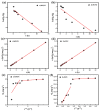Adsorption Behavior and Mechanism of Cesium Ions in Low-Concentration Brine Using Ammonium Molybdophosphate-Zirconium Phosphate on Polyurethane Sponge
- PMID: 37444898
- PMCID: PMC10343003
- DOI: 10.3390/ma16134583
Adsorption Behavior and Mechanism of Cesium Ions in Low-Concentration Brine Using Ammonium Molybdophosphate-Zirconium Phosphate on Polyurethane Sponge
Abstract
Salt lake brine originating from Qinghai, China has abundant cesium resources and huge total reserves. The inorganic ion exchangers ammonium molybdophosphate (AMP) and zirconium phosphate (ZrP) have the significant advantages of separating and extracting Cs+ as a special adsorbent. Nevertheless, their high solubility in water leads to a decrease in their ability to adsorb Cs+ in aqueous solutions, causing problems such as difficulty with using adsorbents alone and a difficult recovery. In this work, an environmentally friendly polyurethane sponge (PU sponge) with a large specific surface area is employed as an adsorbent carrier by physically impregnating dopamine-coated AMP and ZrP onto a PU sponge, respectively. The experiment found that under the same conditions, the AMP/PU sponge performs better than the ZrP/PU sponge for Cs+ adsorption. When the amount of adsorbent reaches 0.025 g, the adsorption capacity reaches saturation. The adsorption efficiency remains above 80% when the concentration of Cs+ is 5-35 mg/L. The kinetic calculations show that adsorption is spontaneous, feasible, and has a higher driving force at high temperatures. In addition, the power and mechanism of the interaction between adsorbent and adsorbent are explained using the density functional theory calculation. This efficient, stable, and selective Cs+ adsorbent provides design guidelines.
Keywords: Cs+ adsorption; ammonium molybdophosphate; polyurethane sponge; zirconium phosphate.
Conflict of interest statement
The authors declare no conflict of interest.
Figures












Similar articles
-
Efficient Selective Adsorption of Rubidium and Cesium from Practical Brine Using a Metal-Organic Framework-Based Magnetic Adsorbent.Langmuir. 2024 May 7;40(18):9688-9701. doi: 10.1021/acs.langmuir.4c00647. Epub 2024 Apr 23. Langmuir. 2024. PMID: 38654502
-
Selective removal of cesium by ammonium molybdophosphate - polyacrylonitrile bead and membrane.J Hazard Mater. 2017 Feb 15;324(Pt B):753-761. doi: 10.1016/j.jhazmat.2016.11.054. Epub 2016 Nov 21. J Hazard Mater. 2017. PMID: 27890359
-
Evaluation of optimal size of illite adsorbent for 137Cs removal in contaminated artificial lake.J Environ Manage. 2020 Sep 1;269:110739. doi: 10.1016/j.jenvman.2020.110739. Epub 2020 May 20. J Environ Manage. 2020. PMID: 32560984
-
Development of polyaminated chitosan-zirconium(IV) complex bead adsorbent for highly efficient removal and recovery of phosphorus in aqueous solutions.Int J Biol Macromol. 2020 Dec 1;164:1183-1193. doi: 10.1016/j.ijbiomac.2020.07.218. Epub 2020 Jul 29. Int J Biol Macromol. 2020. PMID: 32735922
-
Selective adsorption of sodium dodecylbenzenesulfonate from a Cs ion mixture by electrospun mesoporous silica nanofibers.Chemosphere. 2020 Nov;259:127391. doi: 10.1016/j.chemosphere.2020.127391. Epub 2020 Jun 16. Chemosphere. 2020. PMID: 32590176
Cited by
-
Advancing in Cesium Retention: Application of Magnesium Phosphate Cement Composites.Materials (Basel). 2024 May 1;17(9):2132. doi: 10.3390/ma17092132. Materials (Basel). 2024. PMID: 38730938 Free PMC article.
References
-
- Hang S., Lingdan Z., Qi L., Shujun G., Zhang H. Urushiol-resourced dopamine analogue as a trigger to construct clay-hexacyanoferrate hydrogel for cesium removal. J. Environ. Eng. 2021;9:106140–106151.
-
- He F., Song E., Zhou Y., Ming H., Chen Z., Wu J., Shao P., Yang X., Xia Z., Zhang Q. A general ammonium salt assisted synthesis strategy for Cr3+-doped hexafluorides with highly efficient near infrared emissions. Adv. Funct. Mater. 2021;31:2103743–2103754. doi: 10.1002/adfm.202103743. - DOI
-
- Gao L., Ma G., Zheng Y., Tang Y., Xie G., Yu J., Liu B., Duan J. Research Trends on Separation and Extraction of Rare Alkali Metal from Salt Lake Brine: Rubidium and Cesium. Solvent Extr. Ion Exch. 2020;38:753–776. doi: 10.1080/07366299.2020.1802820. - DOI
Grants and funding
LinkOut - more resources
Full Text Sources

